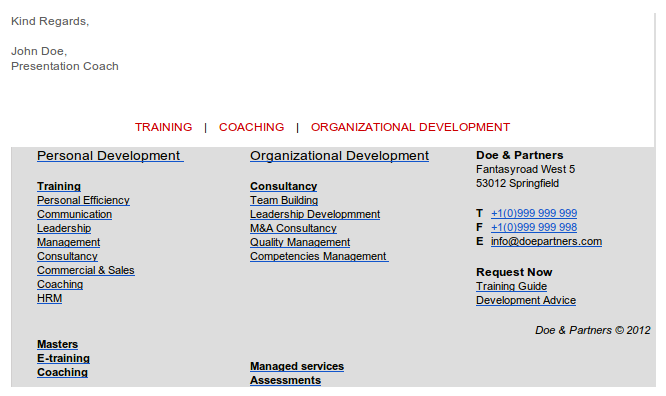Online Marketing for Trainers and Coaches
Most trainers and coaches find it hard to combine their super busy schedule with customer acquisition. They always tell me how, towards the end of a job, they start worrying about getting their next assignment. So, on top of delivering a training session, they now start making phone calls and send out emails to follow up on leads. Too many things to do at once.
How can you fix this problem? It’s not necessarily a problem that acquisition takes time. Marketing always takes time. But it would be nice if you had more options on when to spend that time, instead of frantically trying to make a few more phone calls during lunch hour.
In this post I want to show you how you can employ online marketing to generate new business and free up your schedule a bit. Yes, I know, you’ve already got a website. But putting a website online is like hanging out your shingle. It’s just a statement that you’re in business.
You don’t just need a website, you also need a strategy for how to use that website in your online marketing efforts.
Now, online marketing is not a magic bullet. It’s just a form reactive marketing, meaning that customers call you instead of you trying to reach out to them all the time. The question is: how do you get customers to contact you?
Just ask them! Make it an actionable item on your website. In the remainder of this post, we’ll dive into getting traffic for your site, converting visitors into prospects, and converting prospects into customers who contact you.
Getting Traffic
Get your potential customers to talk about you. How? Well, first of all, don’t just try to sell them something, offer them valuable advice. Establish credibility as an expert first, and people will come to consider you an authority. Next time they’re dealing with a problem you’ve discussed before, they’ll call you for a solution.
How do you reach that goal? By separating the expert part from the selling part. Let’s start with the expert part. There are several means you can employ to establish credibility as an expert:
- Create a mailing list: at a regular interval, send out nuggets of information, useful tips and hints.
- Deliver a presentation for a conference – you don’t even have to be super experienced to do this. People always like to hear a “lessons learned” story. And this creates an online presence too, because videotaped conference talks are almost always put online after a few days (e.g. on Youtube).
- Create a presence in social media (Facebook, LinkedIn). Tell little stories about how you helped out a company in your target market.
- Keep a blog and post free but valuable advice. But watch out: your blog is not the same as your commercial website. As a matter of fact, try to keep them separate.
- Write a book. This is the number one way to establish yourself as an actual expert. It provides instant credibility because your expert status has been validated by a publisher.
In all instances mentioned above, it doesn’t hurt to drop your company’s name. Just don’t try to sell anything – that’s what your commercial website is for. The goal here is to establish yourself as an expert. If you also give away freebies, e.g. free but valuable advice, people will start referring you. This is when you start noticing new visitors on your commercial website. Who you will track using a (free) tool like Google Analytics.
By the way, your blog is also a place where you can measure results:
- Keep track of how many people visit your blog.
- See how many visitors sign up for your email list (because your blog is the place where you invite people to do just that: “Sign up for the mailing list and receive a fact sheet on common but easily avoidable mistakes people in your business make”).
- Measure how many people click through to your commercial website (but again, don’t push them, keep a clear separation between “selling” and “establishing authority”).
To summarize, “getting traffic” starts by establishing credibility first. Selling comes much later.
Converting Visitors into Prospects
We have talked about two websites: your blog and your commercial website. Your blog is where you turn visitors into prospects. Once you have established your credibility as an expert, people are more receptive to your advice. Including advice on hiring you for training sessions. Now, let’s stress this point one more time: do not try to sell people anything on your blog (or in your email news letter). Instead, simply mention the options people have when it comes to solving a problem you happen to be an expert on.
For instance, if you are an expert on crime prevention training for shops you may want to announce the dates for new training sessions on securing shops against shoplifting. Don’t do that. Instead, offer specific advice (“ask a friend or relative to visit the store, act suspiciously and find out how alert personnel are”) and then mention that you also provide additional training on this topic. At that point, it’s okay to say something like: “Check out my website, yourwebsite.com, to find out more”, in your newsletter.
On your commercial website, make sure there’s a landing page specifically for the training you discussed. The internet address you printed in your newsletter should actually be a hyperlink pointing to that landing page. For instance, if your landing page for your shoplifting training is yoursite.com/training.html, then the code for the link in your email news letter should be:
<a href="http://yoursite.com/training.html">yourwebsite.com</a>
Once a visitor clicks this link, they are fully qualified prospects. In other words: they are now potential customers.
Converting Prospects into Customers
The next step is to convert your prospects into customers. To facilitate this, put a clear “call to action” on your commercial site. Following the example of the crime prevention trainer, you should include a mini form titled “Enroll into training” on your landing page. Collect only essential data: information you need to get back to the customer as soon as possible to actually subscribe them to the training session.
At this point, you should use all means available to maintain a high level of trust. On the selling page include your:
- address
- phone number (preferably a land line)
- an email address containing your full name (e.g. john.adams@yoursite.nl)
Also think about including your Chamber of Commerce registration number (if you’ve got one) and vat number (for Europeans).
Getting Expert Help
What if all of the above sounds too cumbersome? Then just hire experts who know all about this stuff. They will advice you on specific software for each part of the online marketing we just discussed. Here are a few tips about what tools you could use:
- WordPress for writing and publishing your blog
- MailChimp for managing your email newsletter
- Google Analytics for keeping track of your site’s visitors
There are even agencies who specialize in dealing with all of the above for you.
A final piece of advice on hiring experts: nobody knows your customers as well as you do. So make sure that the experts’ recommendations are applicable to your specific situation.
Post comment


